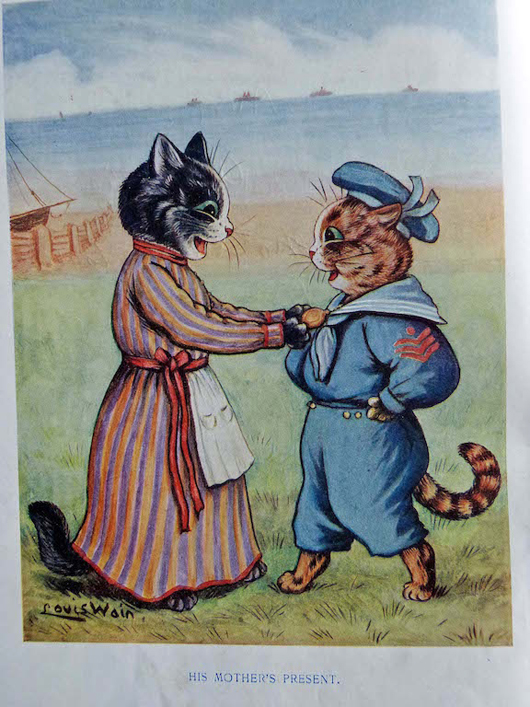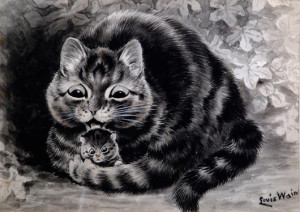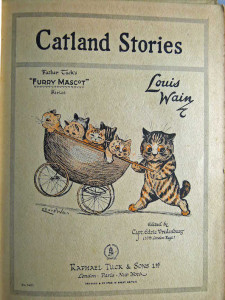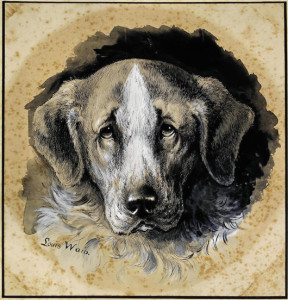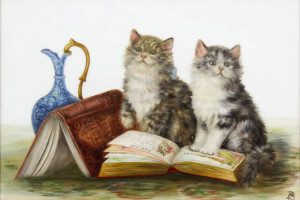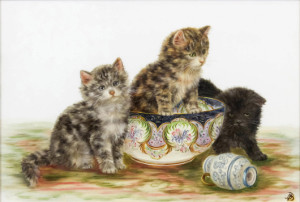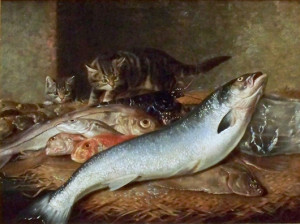LONDON – Ours is a cat loving household, currently – and sadly – sans cat, but what’s all this about the pets becoming Internet superstars? There’s even self-help books on how it’s done and, apparently, the financial rewards can be enormous. Quick, find one with spotted fur and no, I don’t mean a leopard.
The great Edwardian cat artist Louis Wain (1860-1939) developed a fixation for bizarre business investment ideas, including one to breed a spotted cat. Needless to say, his financial position worsened as a result.
He was subsequently certified insane and in June 1924, he was taken to the pauper ward of the local lunatic asylum. He had come to believe he was a cat himself. The diagnosis was schizophrenia.
However, a publisher who organized a public fund to transfer Wain to a private hospital later rescued him and fame followed. It was there that he completed some of his most exciting and daring works in watercolor and crayon, many of which Wain gave away to his nurses and fellow patients, a far cry from the days when he was using sketches to meet unpaid bills.
Wain was born in Clerkenwell, London, the only boy among five sisters. Little is known about his father, but his mother was a textile designer in Leek, Staffordshire. The boy probably took after his mother and his artistic ability was soon noticed: a career as a newspaper and magazine illustrator looked likely.
His first published drawing appeared in the Dec. 10, 1881, edition of the Illustrated Sporting and Dramatic News. A year later, after working for them in a freelance capacity, he joined the staff full-time.
Wain’s “discovery” of cats was born out of tragedy. In 1884, he married his sister’s governess, Emily Richardson, who was 10 years his senior. Their happiness was short-lived, however She contracted cancer and was soon confined to her bed.
One of Emily’s companions during her illness was a black and white kitten called Peter, and Wain spent many hours sketching the pet to amuse his ailing wife. It was some time before Wain was persuaded to show his pictures of Peter, but Sir William Ingram, proprietor of The Illustrated London News, was so impressed, he published two of them.
This led to the breakthrough Wain needed. In 1886, he drew kitten illustrations for “Madam Tabby’s Establishment, followed by A Kitten’s Christmas Party, which appeared in The Illustrated London News that same year.
It brought Wain overnight fame and commissions flooded in from around the world. Sadly, though, his wife never shared in the success. She died after much suffering in 1887. This had a profound effect on Wain and alone, he was a poor financial manager. He also became a target for cranks and senders of begging letters.
Today, Wain would be living high on the hog from sales of his work. A simple postcard bearing one of his unmistakable cartoons can sell for upwards of £20, while full-blown drawings featuring cats in anthropomorphic activities, such as attending school or playing golf or cricket, can command prices into five figures. Even Wain prints and some illustrated children’s books can sell for hundreds.
But there’s more to collecting cats in art than just works by Louis Wain, specially if your pockets are shallower. One of our other favorites is Bessie Bamber, a saleroom regular, but about whom so little is known.
Birkenhead-born Bessie has a following all her own, though. The painting we own by her – or at least we believe it is by her – we found at a flea market and couldn’t resist buying it. Try as we might, though, we cannot see the “BB” monogram, which would confirm beyond doubt that it is really an example of her work. In an auction it would be cataloged as “in the style of.”
Like most of her pictures, it features fluffy kittens in cute poses, painted in oils on either white glazed porcelain panels or, as in our case, opaline glass. Apparently, others have been found painted on mahogany panels.
She was active between 1880 and 1910, probably in Liverpool, and must have been hugely prolific, because her work turns up often in regional auction rooms. The paintings are invariably still in their original frames and usually small in size, measuring around 6 by 9 inches or so.
Single pictures by her sell for around £700-£1,000 in the saleroom, although I watched a sale a couple of years ago in which a pair, one of a kitten sitting in a teapoy, the other showing two kittens by a vase of flowers, each beautifully detailed, realized £5,200, at the time an auction record.
Bessie is also said to have painted pictures of equally adorable puppies, but we have never seen one ourselves.
Another cat artist able to turn her hand equally to dog portraits is Persis Kirmse (1884-1955) who, despite her exotic name, was born in Bournemouth. Both a painter and an etcher, she worked mainly in oils and pastels and made her name painting the pets of the European aristocracy for what must have been lucrative commissions.
Her pictures were used extensively for calendars and postcards and illustrated several children’s books, which she wrote herself. Interestingly Persis’s sister, Marguerite Kimse (1885-1954) built an acclaimed career for herself as an artist, but concentrated solely on dog portraits. Values of works by both sisters are generally in line with those of Bessie Bamber.
Horatio Henry Couldery (1832-1918) or “Kitten Couldery” as he was nicknamed, was born in Lewisham, South London, and trained as a cabinetmaker until aged 25, when he enrolled as a pupil at the Royal Academy of Arts. He exhibited his first painting there in 1861, titled On Dangerous Ground. It shows two tabby kittens hungrily eyeing up several types of fish, which they have discovered uncovered among blocks of ice on a kitchen table.
The oil on canvas is now in the Couldery Collection, kept at Glanmore, a Canadian national historic site in Belleville, Ontario. Couldery’s brother and sister-in-law, Bertram and Cecilia Couldery, traveled to Belleville in the 1880s and owned a second home there, which they filled with 42 of their brother’s pictures, believed to be the largest in the world, together with a large collection of European furniture and works of art.
Couldery’s particular skill, side from the humor of his pictures, was his handling of the cats’ fur. The art critic John Ruskin described on of his cat pictures as “quite the most skillful piece of minutiae and Dureresque painting in the exhibition – it cannot rightly be seen without a lens: and in its sympathy with kitty nature … unsurpassable.”
Admittedly, they don’t purr when you stoke them, but then they don’t scratch the furniture either.



